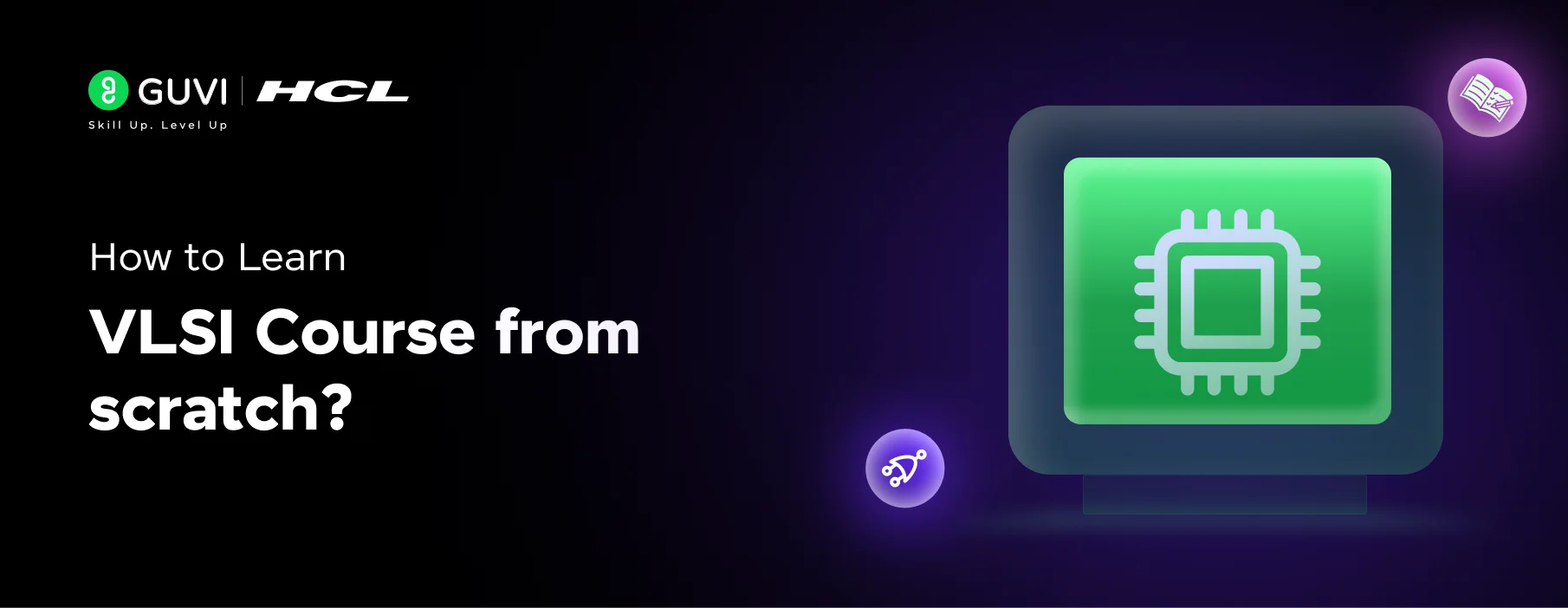
How to Learn VLSI Course from scratch? 12 Steps To Follow
Jan 22, 2025 4 Min Read 2287 Views
(Last Updated)
Learning VLSI (Very Large Scale Integration) design is a transformative journey into the world of semiconductor technology. As the backbone of modern electronics, VLSI enables the creation of advanced integrated circuits that power everything from smartphones to AI systems.
Whether you’re a student, a professional, or an enthusiast, understanding how to learn VLSI course from scratch can open doors to exciting opportunities in this high-demand field.
This guide offers a comprehensive roadmap to help you build a strong foundation, master essential skills, and confidently approach the complexities of VLSI design.
Table of contents
- What is VLSI Design?
- Key Aspects of VLSI Design:
- How to Learn VLSI Course from Scratch: A Step-by-Step Guide
- Build a Strong Foundation in Electronics
- Master Digital Logic Design
- Learn Hardware Description Languages (HDLs)
- Understand the VLSI Design Flow
- Get Familiar with EDA Tools
- Work on Projects
- Enroll in Online Courses
- Participate in Workshops and Webinars
- Join VLSI Communities and Forums
- Pursue Certifications
- Stay Updated with Industry Trends
- Gain Real-World Experience
- Benefits of Learning a VLSI Design Course
- Conclusion
- FAQs
- What is VLSI design, and why is it important?
- What prerequisites are needed to start learning VLSI design?
- How long does it typically take to learn VLSI design from scratch?
- What career opportunities are available after learning VLSI design?
- Are there online resources available for learning VLSI design?
What is VLSI Design?
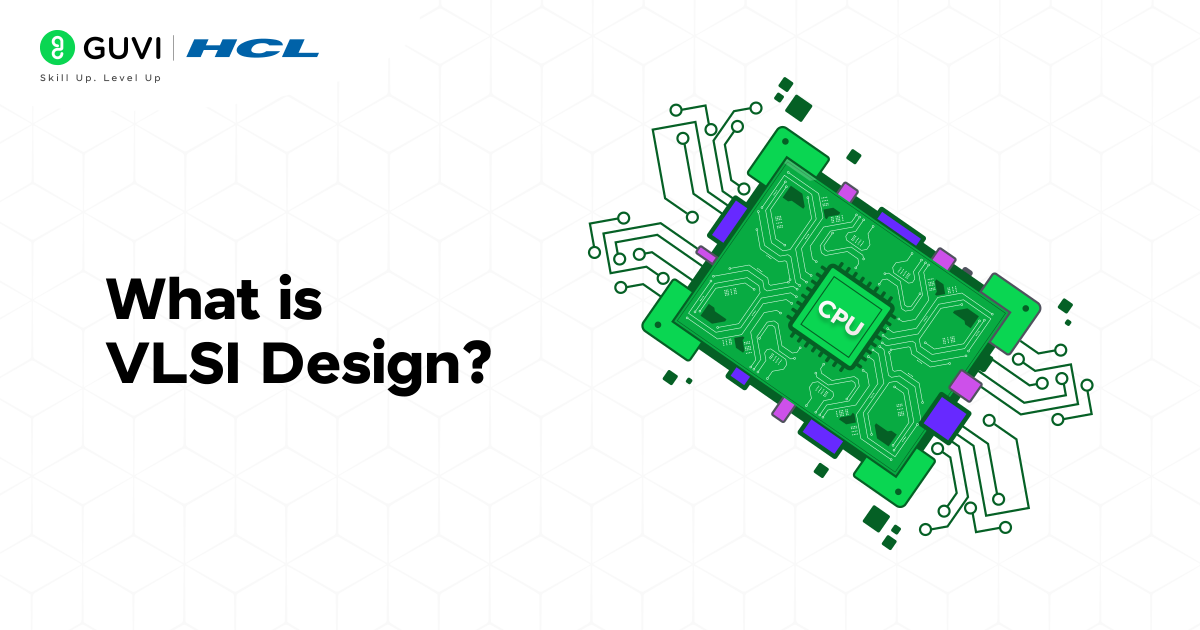
VLSI (Very Large Scale Integration) design is the process of creating integrated circuits (ICs) by combining millions (or even billions) of transistors onto a single chip. These ICs are the building blocks of modern electronic devices such as smartphones, laptops, and microprocessors.
The term “VLSI” emerged during the 1970s as a result of advancements in semiconductor technology that made it possible to integrate thousands of transistors into a single chip. Today, VLSI design plays a critical role in creating compact, high-performance, and energy-efficient devices.
Key Aspects of VLSI Design:
- Design Flow:
The VLSI design process involves several stages, including specification, architectural design, logic design, physical design, verification, and testing. These steps ensure that the chip functions correctly and meets performance requirements. - Hardware Description Languages (HDLs):
Designers use HDLs like Verilog and VHDL to describe and simulate digital circuits before physical implementation. - EDA Tools:
Electronic Design Automation (EDA) tools assist in creating, verifying, and optimizing chip designs, streamlining the complex design process. - Applications:
VLSI technology is used in a variety of fields, including microprocessors, memory chips, signal processing, artificial intelligence, and communication devices.
VLSI design is the backbone of modern electronics, enabling the development of powerful and compact devices that drive today’s technological advancements.
How to Learn VLSI Course from Scratch: A Step-by-Step Guide
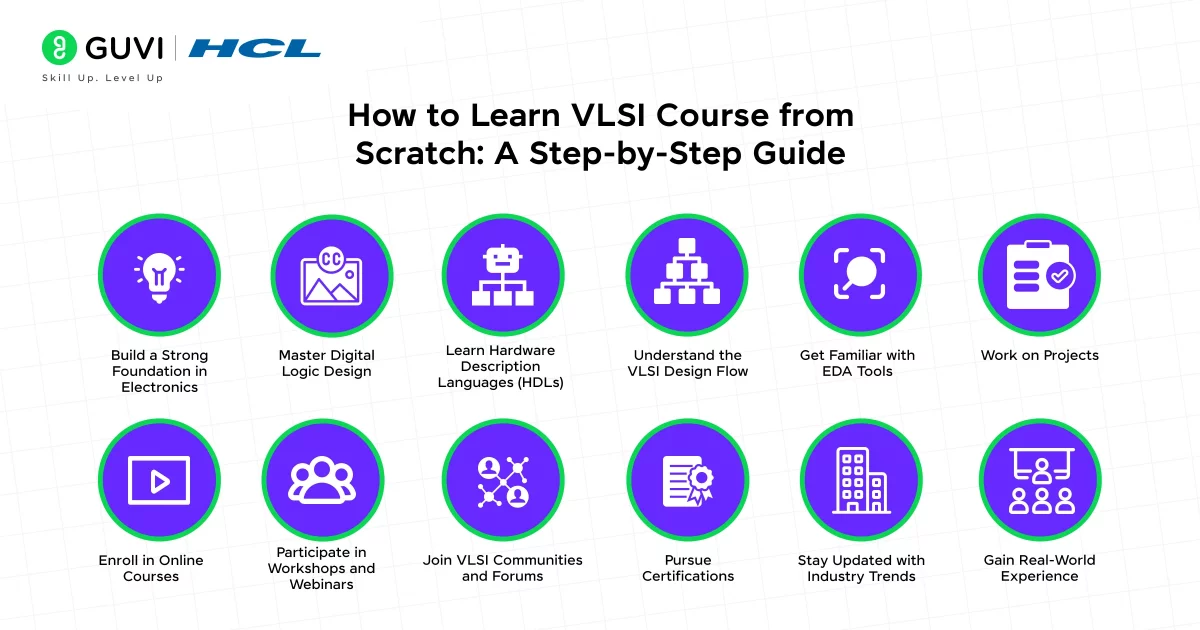
Learning VLSI design from scratch may seem overwhelming, but with a structured approach and the right resources, you can master it effectively. Here’s a detailed step-by-step guide to help you get started.
1. Build a Strong Foundation in Electronics
VLSI design is built on the fundamentals of electronics. Start by understanding basic concepts like:
- Voltage, current, resistance, and power.
- Ohm’s Law, Kirchhoff’s Laws, and basic circuit analysis.
- Passive components like resistors, capacitors, and inductors.
- Semiconductor basics (diodes, transistors, and MOSFETs).
Recommended Resources:
- Books: Electronic Devices and Circuit Theory by Boylestad and Nashelsky.
- Online platforms: Khan Academy, Coursera, and YouTube.
2. Master Digital Logic Design
Digital logic design is at the heart of VLSI. It deals with the principles of digital circuits and their behavior. Focus on:
- Boolean algebra and logic simplifications.
- Logic gates (AND, OR, NOT, XOR, etc.).
- Combinational circuits (multiplexers, decoders, adders, etc.).
- Sequential circuits (flip-flops, latches, counters, and registers).
Practical Tip: Use simulation tools like Logisim to practice designing circuits.
3. Learn Hardware Description Languages (HDLs)
HDLs like Verilog and VHDL are essential for designing, simulating, and implementing digital circuits. They allow you to describe hardware behavior programmatically.
- Start with the syntax and basics of Verilog or VHDL.
- Practice designing simple modules (e.g., an adder or a multiplexer).
- Gradually move to more complex designs like finite state machines.
Recommended Tools:
- Xilinx Vivado or ModelSim for writing and simulating HDL code.
4. Understand the VLSI Design Flow
The VLSI design flow is the process that transforms an idea into a fully functional integrated circuit. Learn about its stages:
- Specification: Define functionality and requirements.
- Design: Create the architecture and logic using HDLs.
- Verification: Test the design for errors using simulation.
- Synthesis: Convert high-level HDL code into gate-level designs.
- Physical Design: Map the design onto silicon (placement and routing).
- Fabrication: Manufacture the chip.
- Testing: Validate the final product’s functionality.
5. Get Familiar with EDA Tools
Electronic Design Automation (EDA) tools are software applications used for designing and verifying circuits. Industry-standard tools include:
- Cadence: For physical design and layout.
- Synopsys: For logic synthesis and verification.
- Mentor Graphics: For design-for-testability and verification.
Tip: Start with educational versions or open-source tools like KiCAD or Magic VLSI to practice.
6. Work on Projects
Hands-on experience is crucial in VLSI learning. Start with small projects like:
- Designing basic logic gates and circuits.
- Creating a 4-bit counter or a simple ALU (Arithmetic Logic Unit).
- Simulating a processor or memory block.
As you gain confidence, tackle advanced projects like a microcontroller design or an FPGA implementation.
Recommended Platforms:
- FPGA development boards like Xilinx or Altera.
- Online project repositories like GitHub.
7. Enroll in Online Courses
Many online courses provide structured content for VLSI learning. These courses often combine theory with practical exercises. Consider these:
- VLSI Design and Verification by GUVI
- VLSI Design Basics by Maven Silicon.
- Digital VLSI Design on Coursera (University of Illinois).
- VLSI System Design (VSD) on Udemy.
8. Participate in Workshops and Webinars
Workshops and webinars conducted by industry professionals can provide insights into real-world VLSI design. They often cover:
- Current trends and challenges in VLSI.
- Hands-on sessions with industry-grade tools.
- Networking opportunities with experts.
9. Join VLSI Communities and Forums
Engaging with online communities allows you to learn from others, seek guidance, and stay motivated. Popular forums and platforms include:
- Stack Overflow: For coding and debugging questions.
- Reddit (r/electronics): For discussing electronics and VLSI.
- Design & Verification Club: A specialized community for VLSI enthusiasts.
10. Pursue Certifications
Certifications validate your skills and increase your employability. Some reputable certifications include:
- Cadence Certified VLSI Designer.
- Synopsys Certified Professional.
- Mentor Graphics Certified Engineer.
11. Stay Updated with Industry Trends
The VLSI field evolves rapidly with advancements like AI accelerators, RISC-V processors, and 3D ICs. Stay informed by:
- Reading industry blogs (e.g., Semiconductor Engineering).
- Following conferences like DAC (Design Automation Conference).
- Subscribing to journals like IEEE Transactions on VLSI.
12. Gain Real-World Experience
Internships and research projects provide hands-on exposure to real-world challenges in VLSI. Look for opportunities at semiconductor companies or universities.
Learning VLSI design from scratch requires patience, dedication, and a systematic approach. Start by building your knowledge base, practice using tools and HDLs, and work on real-world projects.
Benefits of Learning a VLSI Design Course
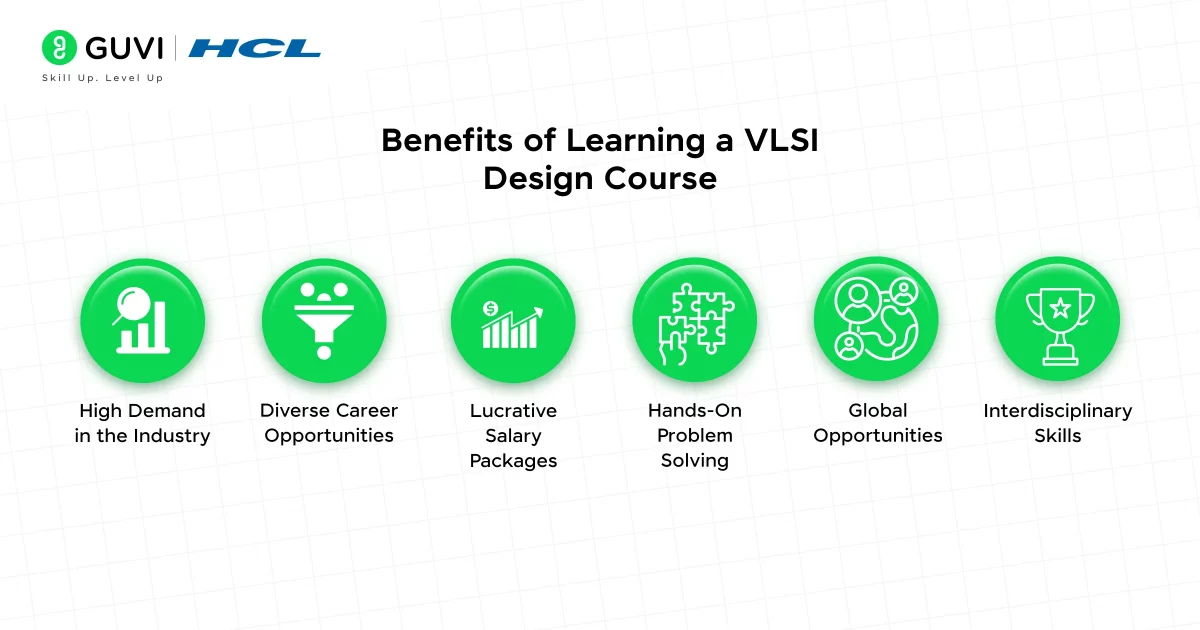
- High Demand in the Industry:
The semiconductor industry is rapidly growing, with increasing demand for skilled VLSI designers to create advanced integrated circuits for devices like smartphones, AI systems, and IoT devices. - Diverse Career Opportunities:
VLSI expertise opens up various career paths, including roles such as ASIC/FPGA designer, verification engineer, physical design engineer, and design automation engineer. - Lucrative Salary Packages:
Salaries for VLSI designers in India vary based on factors like experience, location, and the specific employer. Here’s an overview:
- Entry-Level Positions: Fresh graduates can expect starting salaries ranging from ₹1.8 lakh to ₹5 lakh per annum.
Collegedunia - Mid-Level Positions (2–5 years of experience): Professionals in this bracket typically earn between ₹5 lakh and ₹13 lakh per annum.
Collegedunia - Senior Positions (5+ years of experience): Experienced VLSI designers can command salaries upwards of ₹20 lakh per annum, with some earning as high as ₹37 lakh per annum. AmbitionBox
- Hands-On Problem Solving:
Learning VLSI equips you with practical skills to design, simulate, and optimize real-world systems, enhancing your engineering and analytical capabilities. - Global Opportunities:
Semiconductor companies worldwide seek VLSI experts, offering the chance to work with leading firms like Intel, Qualcomm, AMD, and TSMC. - Interdisciplinary Skills:
VLSI combines knowledge of electronics, programming, and hardware design, making it a versatile field that integrates multiple technical domains.
A VLSI design course not only enhances your technical expertise but also opens doors to exciting and rewarding career opportunities in one of the most dynamic fields of technology.
If you want to learn VLSI design through a step-by-step process guided by a professional mentor that includes Digital Electronics, UNIX and even Shell Scripting, consider enrolling in GUVI’s Certified VLSI Design Course which not only teaches you everything about the subject but also provides you with an industry-grade certificate!
Conclusion
In conclusion, mastering VLSI design is a rewarding journey that demands a mix of theoretical knowledge, hands-on practice, and persistence.
By following a structured learning path, leveraging the right resources, and staying updated with industry trends, you can build expertise and position yourself for a successful career in the semiconductor industry.
Remember, every expert starts as a beginner, stay curious, keep learning, and embrace the challenges of VLSI design as stepping stones toward innovation and growth.
FAQs
VLSI (Very Large Scale Integration) design involves creating integrated circuits by combining thousands to millions of transistors on a single chip. It’s crucial for developing compact, efficient, and high-performance electronic devices like smartphones and computers.
A solid understanding of basic electronics, digital logic design, and familiarity with programming concepts is essential. Knowledge of hardware description languages like Verilog or VHDL is also beneficial.
The time required varies based on individual dedication and prior knowledge. Generally, acquiring a foundational understanding may take several months, while achieving proficiency can take a year or more of focused study and practice.
Proficiency in VLSI design opens doors to roles such as VLSI Design Engineer, Verification Engineer, Physical Design Engineer, and ASIC/FPGA Designer in industries like semiconductor manufacturing and consumer electronics.
Yes, numerous online platforms offer courses and tutorials on VLSI design, including Coursera, Udemy, and edX. Additionally, many universities provide free course materials and lectures on this subject.

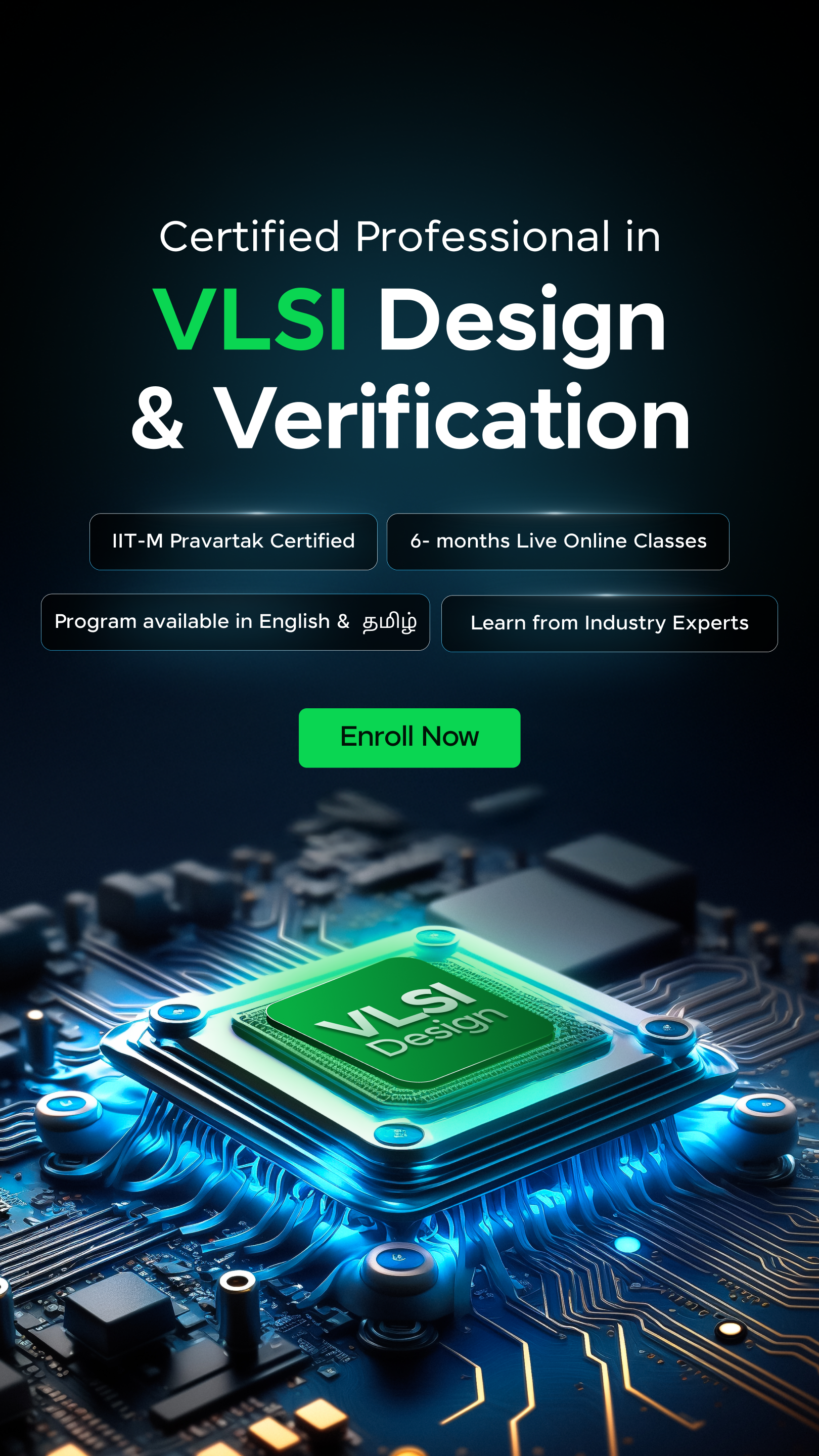



















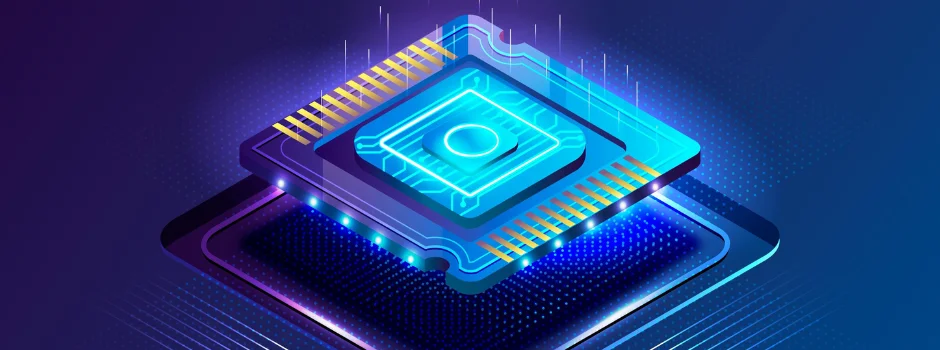

![Top 8 VLSI Design Job Roles [2025] 7 vlsi design job roles](https://www.guvi.in/blog/wp-content/uploads/2025/03/Top-8-VLSI-Design-Job-Roles.png)
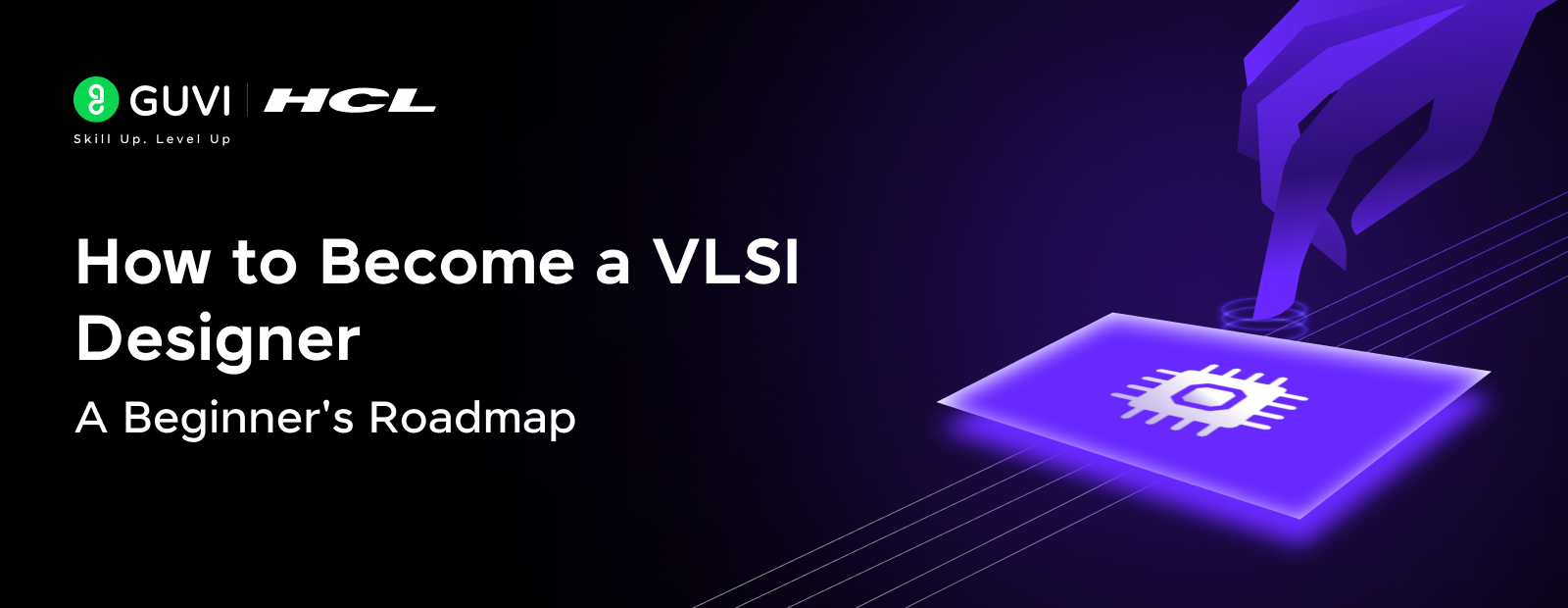

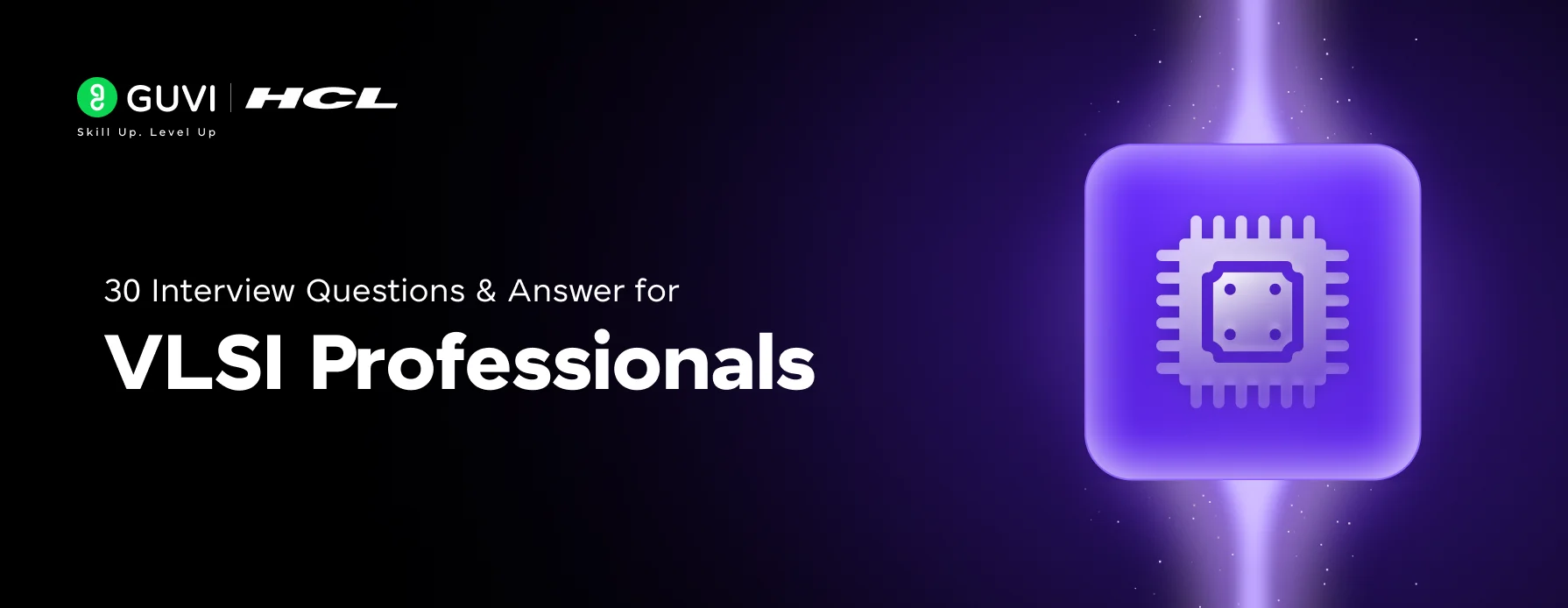




how to learn vlsi from online